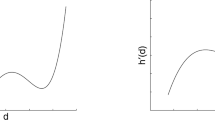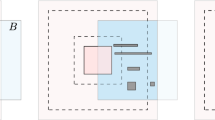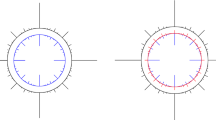Abstract
In a set of infinitely many reference configurations differing from a chosen fit region \({\mathscr {B}}\) in the three-dimensional space and from each other only by possible crack paths, a set parameterized by special measures, namely curvature varifolds, energy minimality selects among possible configurations of a continuous body those that are compatible with assigned boundary conditions of Dirichlet-type. The use of varifolds allows us to consider both “material phase" (cracked or non-cracked) and crack orientation. The energy considered is gradient polyconvex: it accounts for relative variations of second-neighbor surfaces and pressure-confinement effects. We prove existence of minimizers for such an energy. They are pairs of deformations and curvature varifolds. The former ones are taken to be SBV maps satisfying an impenetrability condition. Their jump set is constrained to be in the varifold support.
Similar content being viewed by others
Notes
By Lusin’s theorem, measurable functions f into topological spaces with a countable basis can be approximated by continuous functions on arbitrarily large portions of their domain. Also, if \(f:\Omega \rightarrow {{\mathbb {R}}}^N\) is locally summable in Lebesgue’s sense, by the Lebesgue differentiation theorem almost every x in \(\Omega \) is a Lebesgue point of f, i.e., a point such that for some \(\lambda \in {{\mathbb {R}}}^N\)
$$\begin{aligned} \lim _{r\rightarrow 0^+}\frac{1}{|B(x,r)|}\int _{B(x,r)}|f(z)-\lambda |\;\mathrm {d}x=0 \end{aligned}$$with B(x, r) a ball of radius r, centered at x, which Lebesgue measure is |B(x, r)|. The number \(\lambda =f(x)\) is called Lebesgue value of f at x.
References
Allard, W.K.: On the first variation of a varifold. Ann. Math. 95, 417–491 (1972)
Allard, W.K.: On the first variation of a varifold: boundary behavior. Ann. Math. 101, 418–446 (1975)
Almgren F. J. Jr. (1965), Theory of varifolds, mimeographed notes, Princeton (1965)
Ambrosio, L.: A new proof of the \(SBV\) compactness theorem. Calc. Var. Par. Diff. Equ. 3, 127–137 (1995)
Ambrosio, L., Braides, A., Garroni, A.: Special functions with bounded Variation and with weakly differentiable traces on the jump set. NoDEA Nonlin. Diff. Equ. Appl. 5, 219–243 (1998)
Ambrosio, L., Fusco, N., Pallara, D.: Functions of bounded variation and free discontinuity problems. Oxford University Press, Oxford (2000)
Balint, D.S., Deshpande, V.S., Needleman, A., van der Giessen, E.: Discrete dislocation plasticity analysis of the wedge indentation of films. J. Mech. Phys. Solids 54, 2281–2303 (2006)
Bassani, J.L., Needleman, A., van der Giessen, E.: Plastic flow in a composite: a comparison of nonlocal continuum and discrete dislocation predictions. Int. J. Solids Struct. 38, 833–853 (2001)
Benešová, B., Kružík, M., Schlömerkemper, A.: A note on locking materials and gradient polyconvexity. Math. Mod. Methods Appl. Sci. 28, 2367–2401 (2018)
Bisconti, L., Mariano, P.M., Markenscoff, X.: A model of isotropic damage with strain-gradient effects: existence and uniqueness of weak solutions for progressive damage processes. Math. Mech. Solids 24, 2726–2741 (2019)
Capriz, G.: Continua with latent microstructure. Arch. Rational Mech. Anal. 90, 43–56 (1985)
Ciarlet, P.G., Nečas, J.: Unilateral problems in nonlinear three-dimensional elasticity. Arch. Rat. Mech. Anal. 97, 171–188 (1987)
Coleman, B.D., Hodgdon, M.: On shear bands in ductile materials. Arch. Rat. Mech. Anal. 90, 219–247 (1985)
Dal Maso, G., Toader, R.: A model for the quasi-static growth of brittle fractures: Existence and approximation results. Arch. Rational Mech. Anal. 162, 101–135 (2002)
De Giorgi, E.: New problems on minimizing movements, in Ennio De Giorgi - Selected Papers, L. Ambrosio, G Dal Maso, M. Forti, M. Miranda, S. Spagnolo Edt.s, pp. 699-713, Springer Verlag, 2006 (1993)
Duda, F.P., Šilhavý, M.: Dislocation walls in crystals under single slip. Comp. Meth. Appl. Mech. Eng. 193, 5385–5409 (2004)
Dunn, J.E., Serrin, J.: On the thermomechanics of intertistitial working. Arch. Rational Mech. Anal. 88, 95–133 (1985)
Federer, H., Fleming, W.H.: Normal and integral currents. Ann. of Math. 72, 458–520 (1960)
Feuerbacher, M., Heggen, M.: Metadislocations in complex metallic alloys and their relation to dislocations in icosahedral quasicrystals, Israel. J. Chem. 51, 1235–1245 (2011)
Fleck, N.A., Hutchinson, J.W.: A phenomenological theory for strain gradient effects in plasticity. J. Mech. Phys. Solids 41, 1825–1857 (1993)
Fleck, N.A., Hutchinson, J.W.: Strain gradient plasticity. Adv. Appl. Mech. 33, 295–361 (1997)
Fleck, N.A., Muller, G.M., Ashby, M.F., Hutchinson, J.W.: Strain gradient plasticity: theory and experiment, Acta Metall. Mater. 42, 475–487 (1994)
Francfort, G.A., Marigo, J.J.: Revisiting brittle fracture as an energy minimization problem. J. Mech. Phys. Solids 46, 1319–1342 (1998)
Giaquinta, M., Mariano, P.M., Modica, G.: A variational problem in the mechanics of complex materials. Disc. Cont. Dyn. Syst. A 28, 519–537 (2010a)
Giaquinta, M., Mariano, P.M., Modica, G., Mucci, D.: Ground states of simple bodies that may undergo brittle fracture. Physica D - Nonlin. Phenomena 239, 1485–1502 (2010b)
Giaquinta, M., Modica, G., Souček, J.: Cartesian currents, weak diffeomorphisms and existence theorems in nonlinear elasticity, Arch. Rational Mech. Anal., 106, 97-159. Erratum and addendum, Arch. Rational Mech. Anal., (1990) 109, 385-392 (1989)
Giaquinta, M., Modica, G., Souček, J.: Cartesian Currents in the Calculus of Variations, voll. Springer-Verlag, Berlin, I and II (1998)
Griffith, A.A.: The phenomena of rupture and flow in solids, pp. 163–198. Phil. Trans. Royal Soc. A, CCXXI (1920)
Gudmundson, P.: A unified treatment of strain gradient plasticity. J. Mech. Phys. Solids 52, 1379–1406 (2004)
Gurtin, M.E.: On the plasticity of single crystals: free energy, microforces, plastic-strain gradients. J. Mech. Phys. Solids 48, 989–1036 (2000)
Gurtin, M.E.: A gradient theory of small-deformation isotropic plasticity that accounts for the Burgers vector and for dissipation due to plastic spin. J. Mech. Phys. Solids 52, 2545–2568 (2004)
Gurtin, M.E.: A finite-deformation, gradient theory of single-crystal plasticity with free energy dependent on densities of geometrically necessary dislocations. Int. J. Plast. 24, 702–725 (2008)
Gurtin, M.E., Anand, L.: Thermodynamics applied to gradient theories involving the accumulated plastic strain: the theories of Aifantis and Fleck and Hutchinson and their generalization. J. Mech. Phys. Solids 57, 405–421 (2009)
Korteweg, D.J.: Sur la Forme que Prennent les Équations du Mouvements des Fluides si l’on Tient Compte des Forces Capillaires causées par des Variations de Densité Considérables mais Continues et sur la Théorie de la Capillarité dans l’Hipothèse d’une Variation Continue de la Densité. Arch. Néerl. Sci. Exactes Nat. Ser. II 6, 1–24 (1901)
Kröner, E.: Allgemeine Kontinuumstheorie der Versetzungen und Eigenspannungen. Arch. Ration. Mech. Anal. 4, 273–334 (1960)
Kružík, M., Pelech, P., Schlömerkemper, A.: Gradient polyconvexity in evolutionary models of shape-memory alloys. J. Opt. Theory Appl. 184, 5–20 (2020)
Kružík, M., Roubíček, T.: Mathematical methods in continuum mechanics of solids. Springer, Switzerland (2019)
Lee, E.H.: Elastic-plastic deformations at finite strains. J. Appl. Mech. 3, 1–6 (1969)
Lubensky, T.C., Ramaswamy, S., Toner, J.: Hydrodynamics of icosahedral quasicrystals. Phys. Rev. B 32, 7444–7452 (1985)
Mantegazza, C.: Curvature varifolds with boundary. J. Diff. Geom. 43, 807–843 (1996)
Mariano, P.M.: On the axioms of plasticity. Int. J. Solids Struct. 35, 1313–1324 (1998)
Mariano, P.M.: Mechanics of quasi-periodic alloys. J. Nonlin. Sci. 16, 45–77 (2006)
Mariano, P.M.: Geometry and balance of hyper-stresses. Rendiconti Lincei, Matematica e Applicazioni 18, 311–331 (2007)
Mariano, P.M.: Physical significance of the curvature varifold-based description of crack nucleation. Rendiconti Lincei 21, 215–233 (2010)
Mariano, P.M.: Second-neighbor interactions in classical field theories: invariance of the relative power and covariance. Math. Meth. Appl. Sci. 40, 1316–1332 (2017)
Mariano, P.M.: Mechanics of dislocations and metadislocations in quasicrystals and their approximants: power invariance and balance. Cont. Mech. Thermodyn. 31, 373–399 (2019)
Mariano, P.M., Galano, L.: Fundamentals of the mechanics of solids. Birkhäuser, Boston (2015)
Miehe, C.: A constitutive frame of elastoplasticity at large strains based on the notion of a plastic metric. Int. J. Solids Struct. 35, 3859–3897 (1998)
Mielke, A.: Finite elastoplasticity, Lie groups and geodesics on \(SL\left( d\right) \). In: Newton, P.K., Weinstein, A., Holmes, P.J. (eds.) Geometry, dynamics and mechanics, pp. 61–90. Springer-Verlag, New York (2002)
Mielke, A.: Energetic formulation of multiplicative elasto-plasticity using dissipation distances. Cont. Mech. Thermodyn. 15, 351–382 (2003)
Parry, G.P.: Generalized elastic-plastic decomposition in defective crystals. In: Capriz, P.M., Mariano, Ed. (eds.) in Advances in multifield theories for continua with substructure, G, pp. 33–50. Birkh äuser, Boston (2004)
Phillips, R.: Crystals. Defects and Microstructures. Cambridge University Press (2001)
Reina, C., Conti, S.: Kinematic description of crystal plasticity in the finite kinematic framework: a micromechanical understanding of \(F=F^{e}F^{p}\). J. Mech. Phys. Solids 67, 40–61 (2014)
Reina, C., Schlömerkemper, A., Conti, S.: Derivation of F=FeFp as the continuum limit of crystalline slip. J. Mech. Phys. Solids 89, 231–254 (2016)
Segev, R.: Geometric analysis of hyper-stresses. Int. J. Eng. Sci. 120, 100–118 (2017)
Simo, J.C., Hughes, T.R.J.: Computational inelasticity. Springer-Verlag, Berlin (1998)
Vardoulakis, I., Aifantis, E.C.: A gradient flow theory of plasticity for granular materials. Acta Mech. 87, 197–217 (1991)
Yefimov, S., van der Giessen, E.: Multiple slip in a strain-gradient plasticity model motivated by a statistical-mechanics description of dislocations. Int. J. Solids Struct. 42, 3375–3394 (2005)
Acknowledgements
This work has been developed within the activities of the research group in “Theoretical Mechanics” of the “Centro di Ricerca Matematica Ennio De Giorgi” of the Scuola Normale Superiore in Pisa. PMM wishes to thank the Czech Academy of Sciences for hosting him in Prague during February 2020 as a visiting professor. We acknowledge also the support of GAČR-FWF project 19-29646L (to MK), GNFM-INDAM (to PMM), and GNAMPA-INDAM (to DM).
Author information
Authors and Affiliations
Corresponding author
Additional information
Communicated by Arash Yavari.
Publisher's Note
Springer Nature remains neutral with regard to jurisdictional claims in published maps and institutional affiliations.
Rights and permissions
About this article
Cite this article
Kružík, M., Mariano, P.M. & Mucci, D. Crack Occurrence in Bodies with Gradient Polyconvex Energies. J Nonlinear Sci 32, 16 (2022). https://doi.org/10.1007/s00332-021-09769-3
Received:
Accepted:
Published:
DOI: https://doi.org/10.1007/s00332-021-09769-3




